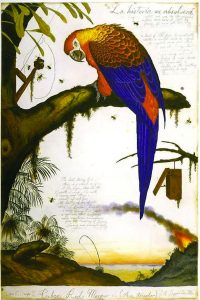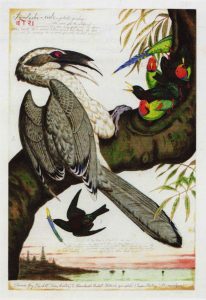
Benjamin’s Emblem, 2000

Compromised, 2003

La Historia Me Absolvera,1999

Swadeshi-cide, 1998

The Tale of Johnny Nutkin, 2001

Visitation, 2004
The following details apply to each piece:
6 color hardground and softground etching, aquatint, spit-bite aquatint, drypoint and roulette on Somerset satin paper
44 x 30 1/2 in.
A.P.
Pencil signed, dated and numbered
About the work:
Walton Ford is a contemporary American painter and printmaker who draws on the visual and narrative language of traditional natural history painting. He examines how animals exist and survive in relation to human activity, many of the animals he depicts being extinct. Although human figures rarely appear in his work, their presence and effect is always implied.
This week’s Work of the Week! WOW! is a suite of 6 etchings by Walton Ford.
Ford’s color etchings are deeply inspired by 19th century American ornithologist and painter John James Audubon, but they aren’t just a celebration of the natural world like Aududbon’s works. Ford’s paintings are meticulous, realistic studies of flora and fauna, filled with commentary – symbols, clues and jokes referencing text ranging from colonial literature, to folktales, to travel guides. His works are complex, allegorical narratives that critique the history of colonialism, industrialism, politics, natural sciences and humanity’s effect on the environment.
In the work entitled Visitation, for example, Ford’s scene of a large flock of passenger pigeons can be seen eating corn and nuts, and recalls a written description by Audubon, “Whilst feeding, their avidity is at times so great that in attempting to swallow a large acorn or nut, they are seen gasping for a long while as if in the agonies of suffocation.” The overwhelming amount of birds feasting on the bounty of the land could symbolize the exploitation of natural resources by European settlers in the New World, which ultimately led to the extinction of the passenger pigeon.
Another American bird represented in this series can be seen in the piece Benjamin’s Emblem. This is a direct reference to the myth that Benjamin Franklin wanted the turkey as the emblem of the Great Seal of the United States – his proposal for the seal was in fact devoid of birds completely. The turkey in Benjamin’s Emblem is asphyxiating a small Carolina Parakeet, an extinct bird, once the only parakeet indigenous to North America. The wild turkey was the very first print created for Audubon’s Birds of America, celebrating wild American birds. The wild turkey was Audubon’s most idolized, writing about it more than any other in his Ornithological Biography. He sealed letters with a seal bearing the likeness of a turkey and the words “America My Country,” even adopting one as a pet.
Each bird of the series has a story related to human activity such as Colonialism, Imperialism and even Communism, and their ecological effects on nature, specifically birds.
Walton Ford’s work can be found in many public collections in the US, including the Museum of Modern Art, NY; Whitney Museum of American Art, New York; and the Smithsonian American Art Museum, Washington D.C.
